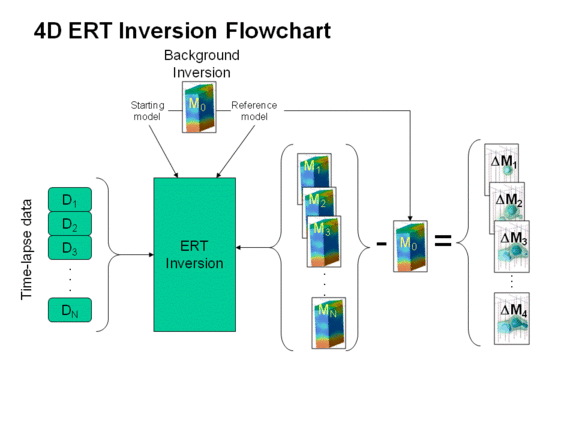Electrical Resistivity Monitoring Primer
Electrical Resistivity Monitoring – Concept
The application of the electrical resistivity method results in a spatial distribution of subsurface electrical properties. By collecting multiple electrical geophysical surveys with the same parameters at the same location at different times, each one of these surveys will result in a spatial distribution of electrical properties associated with the time the survey was collected.
If subsurface processes occur which change the subsurface electrical properties these changes will be visible by examining the sequence of electrical property distributions. This general approach is known as geophysical monitoring (also known as timelapse or 4D geophysics). It has been demonstrated to work for a number of geophysical methods (including electric, seismic, gravity and electromagnetic) for a wide range of applications including oil and gas production, water resource management and remedial efforts. When we use electrical resistivity, we refer to this approach as electrical resistivity monitoring, time lapse electrical resistivity or 4D electrical resistivity.
Electrical Resistivity Monitoring in practice
Electrical resistivity is well suited to be deployed in a monitoring mode as data acquisition can be done automatically and there is no need to move any equipment between surveys. It does require the installation of both electrodes and the acquisition electronics in a semi permanent manner. This typically requires electrode cables and electrodes to be buried, and the use of some kind of enclosure (both to protect against vandalism and against environmental conditions) for the electronics.
Processing of monitoring datasets
Data processing generally starts with inverting of the initial dataset. Subsequent to this we invert each new dataset where we start with the final model obtained from the previous step (see image below). One downside of this approach is that this is not linked directly to subsurface models. This has inspired work by a number of people (Johnson, Versteeg et al. 2009, Tso, Johnson et al. 2020, González-Quirós and Comte 2021) to developing data processing approaches using a data domain approach.

Challenges associated with electrical resistivity Monitoring
Electrical resistivity monitoring is an incredibly powerful method. It provides access to volumetric information which can not be obtained in any other way. By integrating the data with models and supporting field data there is the potential of having near real time information on key processes. Numerous case studies and thousands of publications have shown the value of this method.
These results motivate many groups to want to try to use electrical resistivity monitoring for their project. However, there are multiple challenges that users encounter when deploying this method. These include assessing whether this method is right for a specific site and designing electrode geometries and acquisition schedules which would provide the wanted information. They also include selection and deployment of instrumentation, cables and supporting infrastructure. Finally, once a system is deployed and collecting data users need to manage the collected data and perform analytics – both of which require advanced software and specialized staff.
These challenges mean that a large part of electrical resistivity monitoring is done in research efforts by universities and research organizations such as the United States Geological Survey and the Department of Energy National Laboratories in the United States, Deltares in the Netherlands, BRGM in France and the British Geological Survey in he UK. These organizations generally have dedicated instrumentation and staff members and sustained expertise in this area. For many organizations it does not make sense to develop similar expertise in house.
Subsurface Insights offers a comprehensive solution for organizations who want to use electrical resistivity monitoring. This solution includes novel autonomous hardware and a robust cyberinfrastructure for resistivity monitoring and analytics and result delivery.
Contact us today to find out whether electrical resistivity monitoring makes sense for your site and to find out how Subsurface Insights can help you meet your objectives.
